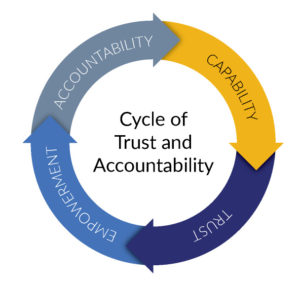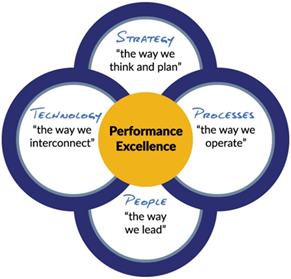What Is a Business System and Why Do You Need One?
By William “Wes” Waldo
Systems and processes are the essential building blocks of our companies. Every facet of your business—on the shop floor, in the warehouse or in the office—is part of a system that can be managed or improved by applying correct principles.
A business system is designed to connect all of an organization’s intricate parts and interrelated steps to work together for the achievement of the business strategy.
When we apply defined principles and practices to the systems and processes that deliver value to our customers, we’re creating what is often referred to as a “business system.”
Creating effective business systems often unifies the problem solving and decision making of the organization. Many common tools and methodologies are universally taught and expected to be utilized by all levels. Several key management structures, such as a full-time Performance Excellence office or systematic maturity assessments, are made a permanent part of the infrastructure. The business system also encompasses how we lead our people and connect them to the operational strategy.
Why Implement a Business System?
There are several reasons to implement a business system.
Improving Top-Line Performance: Part of the business system is the development and implementation of strategy creation, business processes and strategic planning throughout your organization. Those foundational elements lead to a much more insightful way to investigate and grow top-line revenue. In short, a business system takes care of your future. It ensures you meet your customers’ expectations and improve your brand, which are key to growing a healthy business.
If you use a systematic approach, your organization will have constant information on areas that need to be improved and you will begin to understand the unmet needs of customers.
Meeting Customer’s Expectations: If you use a systematic approach, your organization will analyze, measure, compare and test all the possibilities of what your customers want and don’t want. You will have constant information on areas that need to be improved and, even more importantly, you will begin to understand the unmet needs of customers. A business system is key to improving the brand that the organization projects to your community, including customers, employees and suppliers.
Consistent Results: Whether we are considering safety, quality or getting the job done in a timely manner, a business system is designed to give you effective, efficient and repeatable results. In short, the business system gives you a “process to fix your processes.”
Employee Engagement: The goal of the system is to enable proper education and opportunities to all employees so they can complete their work more efficiently and effectively. We also seek to harness their ideas and creativity and, in the process, increase their personal engagement. Additionally, having the system in place allows you to quickly integrate new-hires, and makes it easy for them to see their role within the organization and bring forth new ideas.
Reduce Cost and Increase Profits: It has been proven time and again that the implementation of a sound business system helps reduce costs, but so will many things. A business system is intended to reduce costs without taking the shortcuts that often lead to an erosion of profitability due to the necessity to lower quality expectations or service levels.
The Lean Methods Group’s System of Performance Excellence
At the Lean Methods Group, we use Performance Excellence, among other things, as part of our approach to creating a business system, taking a holistic approach that involves the whole organization. All of the pieces must come together and paint a picture that is clear to each and every employee who views it. Our System of Performance Excellence comprises four parts:
Strategy—the way the organization thinks and plans
Processes—the way the organization operations
People—the way the organization leads
Technology—the way the organization connects
Without a business system, organizations often experience silo-ed thinking. Each department might perform well on its own, but customers don’t see the results of each individual department. Instead, they see the result of the whole.
A business system focuses on alignment of all activities to the customer perspective, from the strategy to employees’ day-to-day work, and installs value-chain-based thinking.
The Power of a Business System
When implementing a business system based on Performance Excellence, there are at least eight major changes that we want the organization to see quickly.
Value-Stream Based—Instead of assigning resources to projects based on financial priority, which means they can be spread all over, we assign resources to a specific site or value stream to work a series of projects. This creates focus, achieving significant transformation in that value stream and allowing the local leadership team to become comfortable using new tools to solve problems. With this approach, we build up islands of excellence much faster.
Such a value stream approach also allows for a more systematic project selection process.
Project Selection—Such a value stream approach also allows for a more systematic project selection process. We don’t want to be haphazardly selecting projects but rather working on initiatives designed to drive toward the achievement of the strategic goals and objectives of the business.
Move to Local—Nearly all improvement teams and kaizen events should be conducted at the local site. No more conference room kaizens! This gets more point-of-action team members involved and experiencing the process first-hand.
Pinpoint Focus—Improvement opportunities such as kaizen events should be scoped with a small enough focus to allow for actual process improvements to be made DURING the run week. Thirty-, 60- and 90-day plans are good for creating a long-term view, but we want to see immediate results both to the bottom line and in the lives of the employees doing the job.
Drum Beat of Success—Process improvements should take place in the same value stream on a consistent monthly basis until we have affected the required amount of improvement and have trained the local team. The “drum beat” of success is of vital importance both from a cultural standpoint and a sustainment point of view.
Replication—By installing a replication process, organizations can take an improvement implemented in one location and duplicate that to all of the other affected locations. This allows the whole organization to see results much faster.
Deployment Dashboard—A deployment dashboard summarizes all results to date and informs the leadership team of expected progress. This dashboard should be communicated on a regular basis. Results have to be measured and shared to sustain success.
Daily Management—Through a thorough Daily Management system in each value stream, we put in place—depending on needs—a tiered meeting structure, visual management boards and leadership standard work. Daily Management is the backbone of sustainability and is often where the most significant improvement opportunities are surfaced.
In addition to these quick-hitting changes listed above, we also expect to see, over a longer period, these other changes to occur.
 Strategy Creation—As part of strategy creation, we explore market and technology trends that highlight opportunities for growth, and identify customer insights using qualitative and quantitative research. Senior leaders learn to become better strategic thinkers and gain a more systematic process for strategy creation.
Strategy Creation—As part of strategy creation, we explore market and technology trends that highlight opportunities for growth, and identify customer insights using qualitative and quantitative research. Senior leaders learn to become better strategic thinkers and gain a more systematic process for strategy creation.
Strategic Planning—With the implementation of the Hoshin Planning process for strategic planning, there’s complete alignment of your organization to the future vision.
Systematic Innovation—Another part of the business system framework is creating a scalable and sustainable innovation ecosystem in order to create competitive advantage. The organization learns to address innovation challenges quickly, build a pipeline of innovation opportunities, prioritize ideas, and apply methods and tools for both front-end innovation and back-end design.
Culture Change—Along the way, the organization starts to see a shift in culture. While some change will happen naturally, other changes must be guiding and steered. To effect positive culture change, the Cycle of Accountability and Trust guides us in forming a virtuous cycle.
With all of those changes taken together, you can see how a business system provides a framework for a constant pursuit of improvement and innovation, and a deep understanding of change and motivation. At the end of the day, when you have all of these things in place, a sound business system gives the organizational leaders confidence in their ability to create the future.
Wes Waldo is COO and President, Americas, at the Lean Methods Group. He is also the author of A Team Leader’s Guide to Lean Kaizen Events.


